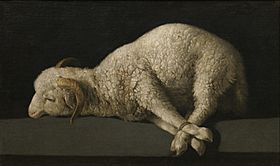Agnus Dei (Zurbarán) facts for kids
The Lamb of God (in Latin, Agnus Dei) is a famous oil painting created by the Spanish Baroque artist Francisco de Zurbarán. He painted it sometime between 1635 and 1640. Today, you can see this beautiful artwork at the Prado Museum in Madrid, Spain.
The painting shows a lamb with its legs tied. This "Lamb of God" is a special symbol from the Christian Bible. In the Gospel of John, John the Baptist calls Jesus "The Lamb of God who takes away the sin of the World." So, the painting reminds people of Jesus and his sacrifice.
You might have even seen this painting on TV! It has appeared in several BBC mystery shows based on Agatha Christie's books. These include And Then There Were None, The Witness for The Prosecution, Ordeal by Innocence, The ABC Murders, and The Pale Horse. In these shows, the painting is used to show how a guilty character feels trapped or is heading for trouble.
Contents
Different Versions of the Painting
Francisco de Zurbarán painted several versions of the Agnus Dei. Each one is a little different, but they all show the same powerful image of the lamb.
The Prado Museum Version
The version of the Agnus Dei at the Prado Museum is very famous. It doesn't have a date or signature, but experts believe Zurbarán painted it between 1635 and 1640. This was a time when he was at his best as an artist. Many people think this is the most successful version of the painting. The Prado Museum bought it in 1986, and it has been on display there ever since.
This painting is quite small, measuring about 38 centimeters (15 inches) tall and 62 centimeters (24 inches) wide. The way Zurbarán painted the lamb's wool, with its simple, curly texture, makes it a very elegant and important work from the Spanish Baroque period.
Other Versions of the Lamb
Zurbarán created other versions of this painting too.
- Agnus Dei GMG Foundation Switzerland: This version was painted in 1631 and is one of the earliest known. It's larger than the Prado version.
- Agnus Dei Plandiura: Painted in 1632, this version is also known as the "Ram with its legs tied." It's considered one of the best versions and is located in Barcelona.
- Agnus Dei Private Collection Madrid: This painting is very similar in size and look to the one in the Prado Museum. It was painted around the same time, between 1635 and 1640.
- Agnus Dei of San Diego: You can find this version at The San Diego Museum of Art. It's interesting because it clearly shows the lamb as a religious symbol. It has a nimbus (a halo-like glow) around the lamb's head and the words "TANQUAM AGNUS" (meaning 'like a lamb') written on it. This makes it clear that it's not just a painting of an animal, but a religious artwork.
See also
 In Spanish: Agnus Dei (Zurbarán) para niños
In Spanish: Agnus Dei (Zurbarán) para niños


